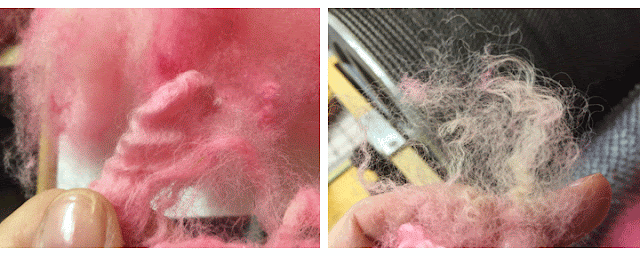Handcarding? Been there. Done that.
 |
| Carded batts ready for spinning |
To speed up my fiber prep, I bought a drum carder made by David Barnett in Sussex, UK long ago. It's a beauty! Shame on me that I let it languish for so number of years. I even gave it away, but with a string attached, so I didn't lose access. Although I've been spinning more than ever, I never expected to need to card wool again. Silly me.
It happened quite by accident. The last shorn ewe at Winter's Past Farm this spring was spectacular. (There is a photo in my blog.) Kris had given me first dibs on it, but I turned it down. However, when I mentioned it to a spinner friend, she offered to split the fleece with me. And now I have half a fleece so, yes, I'll be carding wool this summer.
Renewing a friendship
 |
| David Barnett drum carder |
After borrowing back the drum carder, I put some raw wool on the feeder tray and turned the handle. The drums rotated as they should but the belt skipped. Something was wrong, but I couldn't see it. How lucky I am to have a resident mechanical detective. Maurice quickly.figured it out and now, after a good cleaning and some oil, it works perfectly. (We used light weight, non-petroleum-based Ballistol oil.)
I wanted a little more intimate experience with it so I prepped some dyed Coopworth locks that were in my stash. I had a good laugh when I pulled out my 'dog comb' and found it labeled with the price. £1.95. Clearly it was not a near-recent purchase!
I used the comb, which is shown in the lower right photo, to open up the tips of the locks and any other tight parts before putting it on the feeder. And now I have some lovely batts to spin.
 |
| Lock of fleece: Before and after combing open the tips of the locks. |
 |
Left, top: Carded wool on the drum Right: Fiber ready for second pass into carder
Middle: wool on feeder tray ready for licker
Bottom: Unprepared locks
|
How much wool can you load onto the drum at once? What are the drawbacks of of using raw fleece?
ReplyDeleteHow much wool can you load onto the drum at a time and does it matter if it's raw?
ReplyDelete